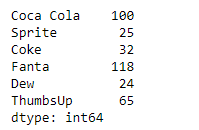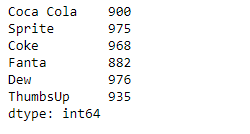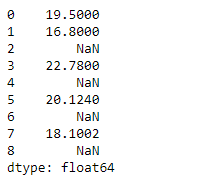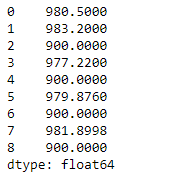Python Pandas Series.sub()
Pandas系列是一个带有轴标签的一维ndarray。标签不需要是唯一的,但必须是一个可散列的类型。该对象支持基于整数和标签的索引,并提供了大量的方法来执行涉及索引的操作。
Pandas Series.rsub()函数返回series和other的减法,是元素的减法(二进制运算符rsub)。它等同于其他-系列,但支持在其中一个输入中用fill_value替代缺失的数据。
语法: Series.rsub(other, level=None, fill_value=None, axis=0)
参数:
other:系列或标量值
fill_value :填补现有的缺失(NaN)值
level :跨层广播,与通过的MultiIndex层上的索引值相匹配。
返回:Series
例子#1:使用Series.rsub()函数对给定的Series对象进行反向减去一个标量元素。
# importing pandas as pd
import pandas as pd
# Creating the Series
sr = pd.Series([100, 25, 32, 118, 24, 65])
# Create the Index
index_ = ['Coca Cola', 'Sprite', 'Coke', 'Fanta', 'Dew', 'ThumbsUp']
# set the index
sr.index = index_
# Print the series
print(sr)
输出 :

现在我们将使用Series.rsub()函数对给定的Series对象与一个标量进行逐元素反向减法。
# perform reverse subtraction with 1000
selected_items = sr.rsub(other = 1000)
# Print the returned Series object
print(selected_items)
输出 :

正如我们在输出中看到的,Series.rsub()函数成功地返回了给定Series对象与标量的反向减法。
示例#2 :使用Series.rsub()函数对给定的Series对象与一个标量元素进行反向减去。给定的系列对象还包含一些缺失的值。
# importing pandas as pd
import pandas as pd
# Creating the Series
sr = pd.Series([19.5, 16.8, None, 22.78, None, 20.124, None, 18.1002, None])
# Print the series
print(sr)
输出 :

现在我们将使用Series.rsub()函数对给定的Series对象与一个标量进行逐个元素的反向减法。我们还将在给定系列对象中的所有缺失值的位置上替换100。
# perform reverse subtraction with 1000
# fill 100 at the place of all missing values
selected_items = sr.rsub(other = 1000, fill_value = 100)
# Print the returned Series object
print(selected_items)
输出 :

正如我们在输出中看到的,Series.rsub()函数成功地返回了给定Series对象与标量的反向减法。
 极客教程
极客教程